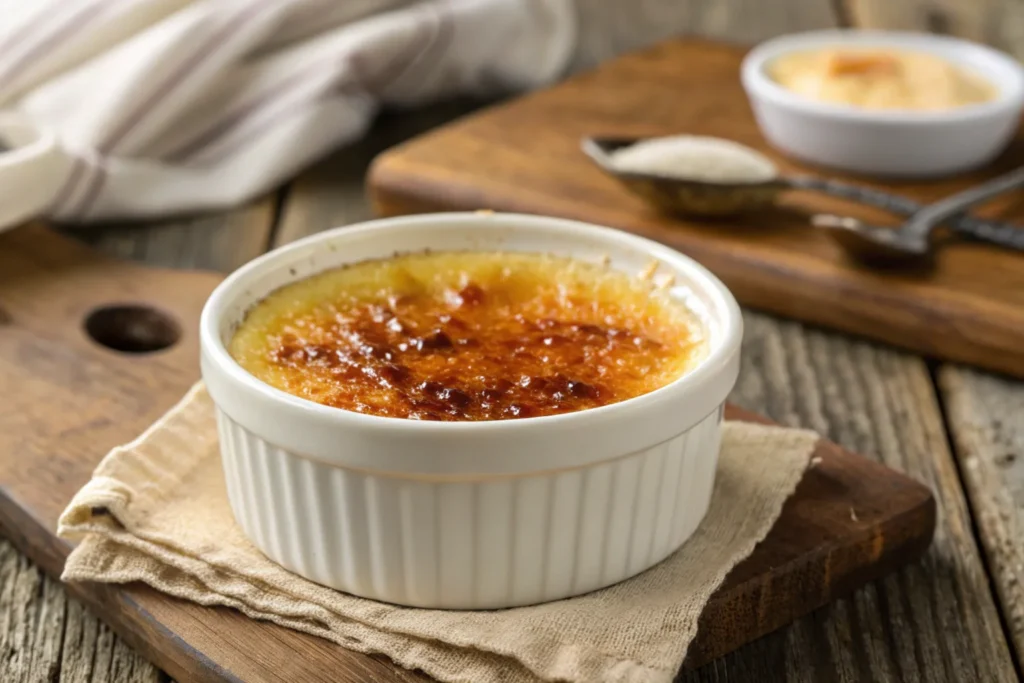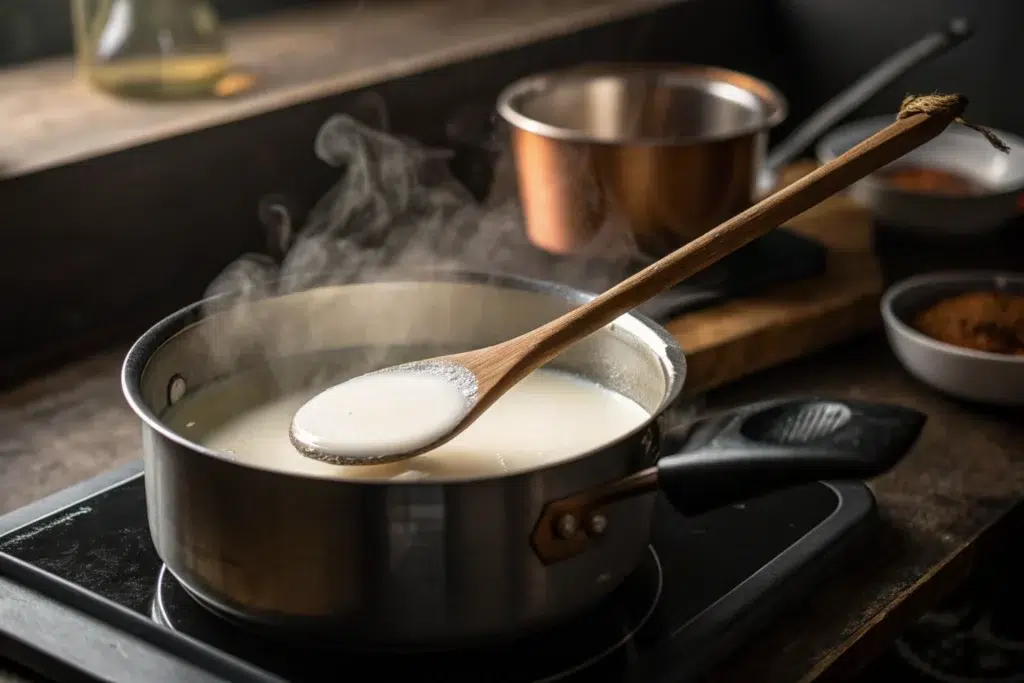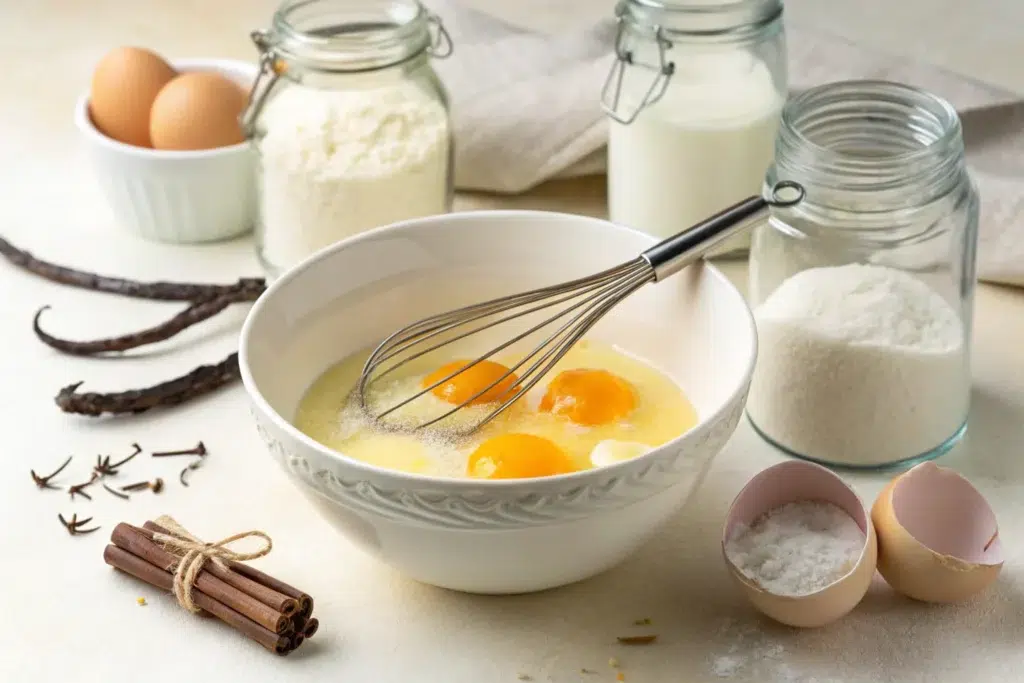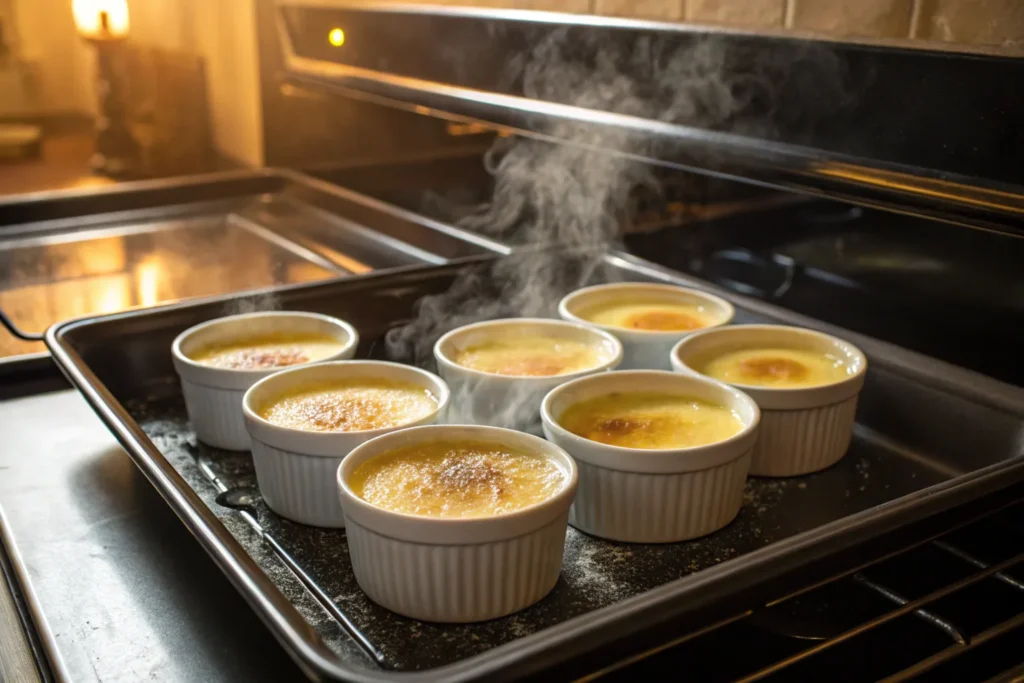Crème brûlée is a dessert known for its elegance and indulgence. Its creamy custard base, topped with a caramelized sugar crust, makes it a timeless favorite. However, what if you don’t have heavy cream on hand? Can you use milk instead of heavy cream in crème brûlée?
The answer is yes, but it comes with some adjustments. Heavy cream is a key ingredient that gives crème brûlée its rich, silky texture. Substituting milk alters the dessert’s consistency and flavor, but with the right techniques, you can still create a delightful dish. If you love experimenting in the kitchen, this is an opportunity to learn more about the science of custards and make the most of what’s in your fridge.
Dive in to uncover how milk compares to heavy cream, what changes to expect, and expert tips for success. If you’re looking for related inspiration, check out What is the Secret of Crème Brûlée? or try a savory twist with the Crab Brulee Recipe.
Why Heavy Cream is Important in Crème Brûlée
The rich and creamy texture of crème brûlée owes much of its magic to heavy cream. While the other ingredients—egg yolks, sugar, and vanilla—play crucial roles, it’s the heavy cream that brings everything together. Here’s why heavy cream is irreplaceable in the traditional recipe:

1. Texture and Creaminess
Heavy cream’s high-fat content, typically around 36–40%, creates the luscious texture that makes crème brûlée irresistible. This fat ensures the custard sets properly while remaining smooth and silky. Without it, the custard may turn out thinner and less indulgent.
2. Depth of Flavor
Heavy cream adds a subtle richness to the custard that elevates its overall flavor. Its luxurious mouthfeel is what makes crème brûlée a standout dessert. Using milk, which has less fat, results in a lighter, less pronounced taste.
3. Stability During Cooking
The fat in heavy cream stabilizes the custard during baking, making it less prone to curdling. This is especially important when the custard is baked in a water bath at low temperatures.
When you’re considering substituting milk for heavy cream, it’s important to understand how these differences can impact your dessert. While milk may work as a replacement, heavy cream offers the richness and structure that defines classic crème brûlée.
Substituting Milk for Heavy Cream: What to Expect
Swapping heavy cream with milk in crème brûlée is possible, but it comes with noticeable changes to the dessert’s texture, flavor, and overall experience. If you’re considering this substitution, here’s what you should know:

1. Texture Changes
Milk has a much lower fat content compared to heavy cream. As a result:
- The custard becomes lighter and less creamy.
- It may not set as firmly, leading to a softer texture.
To compensate, you can add extra egg yolks or a small amount of cornstarch to enhance the custard’s thickness and stability.
2. Flavor Differences
Milk has a milder taste, which reduces the dessert’s richness. Heavy cream provides a depth of flavor that makes crème brûlée indulgent. Using milk might result in a dessert that feels less luxurious. To improve the flavor when using milk, try adding a splash of vanilla extract or even a teaspoon of butter for added richness.
3. Cooking Adjustments
Substituting milk also affects the cooking process. The lower fat content of milk means:
- The custard may cook faster, so you’ll need to reduce the baking time slightly.
- Milk-based custard is more prone to curdling, so maintaining a low, steady oven temperature is critical.
By understanding these differences, you can decide whether substituting milk aligns with your goals for the dessert. With the right adjustments, milk-based crème brûlée can still be a delightful treat.
Best Alternatives to Heavy Cream for Crème Brûlée
If you don’t have heavy cream on hand or are looking for alternatives, there are several options that can deliver satisfying results. While these substitutes may not perfectly replicate the richness of heavy cream, they come close and are worth trying:
1. Half-and-Half
- Why It Works: Half-and-half is a blend of milk and cream, providing a balance of creaminess and lighter texture.
- How to Use It: Replace heavy cream with an equal amount of half-and-half. The custard will be slightly lighter but still delicious.
2. Evaporated Milk
- Why It Works: Evaporated milk has been condensed to remove some of its water content, making it thicker and richer than regular milk.
- How to Use It: Use evaporated milk in the same quantity as heavy cream. It’s an excellent substitute for maintaining a creamy texture.
3. Full-Fat Coconut Milk
- Why It Works: Coconut milk has a high-fat content similar to cream, making it a great dairy-free alternative. It also adds a unique flavor that complements the custard.
- How to Use It: Substitute coconut milk for heavy cream in a 1:1 ratio. Use the full-fat version for the best results.
4. Whole Milk with Butter
- Why It Works: Adding butter to whole milk increases its fat content, mimicking the richness of heavy cream.
- How to Use It: Mix ¾ cup of whole milk with ¼ cup of melted butter to replace 1 cup of heavy cream.
5. Cashew Cream
- Why It Works: Cashew cream, made by blending soaked cashews with water, is another dairy-free option that delivers a creamy texture.
- How to Use It: Replace heavy cream with an equal amount of cashew cream, but be aware that the flavor will differ slightly.
Pro Tip:
When using alternatives, keep in mind that each substitute brings its own unique flavor and texture. Test small batches first to find the best fit for your preferences.
Tips for Success with Milk-Based Crème Brûlée
Switching from heavy cream to milk in crème brûlée requires a few adjustments to maintain the dessert’s quality. Follow these tips to ensure your custard turns out smooth, creamy, and satisfying:
1. Use Whole Milk
- Always choose whole milk for its higher fat content. Avoid 2% or skim milk, as they lack the richness needed for a good custard.
2. Add Extra Egg Yolks
- To compensate for milk’s lower fat content, increase the number of egg yolks in your recipe. This will help the custard set more firmly and give it a creamier texture.

3. Incorporate a Thickener
- Adding a small amount of cornstarch or flour can improve the stability of milk-based custard. Dissolve the thickener in the milk before mixing it with the eggs to avoid lumps.
4. Adjust the Baking Time
- Milk-based custards may cook faster than those made with heavy cream, so keep a close eye on them while baking. Remove the ramekins from the oven as soon as the custard is set around the edges but still slightly jiggly in the center.
5. Enhance the Flavor
- Since milk has a milder flavor than heavy cream, consider adding:
- A splash of vanilla extract or a vanilla bean for depth.
- A small amount of butter for extra richness.
- Citrus zest, like orange or lemon, for a unique twist.
6. Monitor Temperature Carefully
- Bake the custard in a water bath to ensure even cooking and prevent curdling. Use low, consistent heat for the best results.

7. Experiment with Sugar Toppings
- The caramelized sugar topping is the signature element of crème brûlée. Whether you use milk or cream, torch the sugar just before serving to maintain its crisp texture.
Pro Tip:
Milk-based crème brûlée may not replicate the exact richness of the classic version, but with these tips, you can create a lighter yet equally delightful dessert.
FAQs: Can You Use Milk Instead of Heavy Cream in Crème Brûlée?
Yes, you can substitute milk for heavy cream in crème brûlée, but it changes the dessert’s texture and flavor. The custard will be lighter and less creamy, so adding extra egg yolks or a thickener can help maintain its structure.
Using milk instead of heavy cream results in a softer custard with a milder flavor. The lower fat content of milk means the dessert will lack the rich, luxurious texture that heavy cream provides.
Scalding milk (heating it until just below boiling) helps dissolve the sugar and enhances the flavor by infusing any added ingredients like vanilla. It also creates a smoother mixture, preventing lumps when combined with eggs.
No, half-and-half is a mixture of milk and cream with a lower fat content than heavy cream. It can be a good substitute for heavy cream in crème brûlée, but the custard will be slightly lighter in texture.
Yes, overcooking crème brûlée can cause the custard to curdle, resulting in a grainy texture. To avoid this, bake the custard at a low temperature and remove it from the oven when the center is still slightly jiggly.
Yes, canned evaporated milk can be a substitute for heavy cream in crème brûlée. It has a thicker consistency than regular milk, making it a good option for achieving a creamy texture.
Conclusion
So, can you use milk instead of heavy cream in crème brûlée? Yes, but with a few adjustments. While milk lacks the richness and creaminess of heavy cream, it can still produce a delightful custard with a lighter texture and milder flavor. By adding extra egg yolks, incorporating a thickener, and carefully monitoring the baking process, you can create a dessert that satisfies without compromising too much on quality.
If you’re looking for alternatives, options like half-and-half, evaporated milk, or full-fat coconut milk provide better substitutes for heavy cream. Experimenting with these choices can lead to unique variations of this classic dessert.
Whether you stick with traditional heavy cream or try a lighter version with milk, the joy of making crème brûlée lies in cracking through its caramelized sugar topping to reveal the creamy custard beneath. If you want to learn more about crème brûlée techniques, check out What is the Secret of Crème Brûlée? or try the savory twist in this Crab Brulee Recipe.
Crème brûlée is a dessert of endless possibilities—so don’t be afraid to get creative in your kitchen!


5 thoughts on “Can You Use Milk Instead of Heavy Cream in Crème Brûlée? A Dessert Lover’s Guide”
Comments are closed.